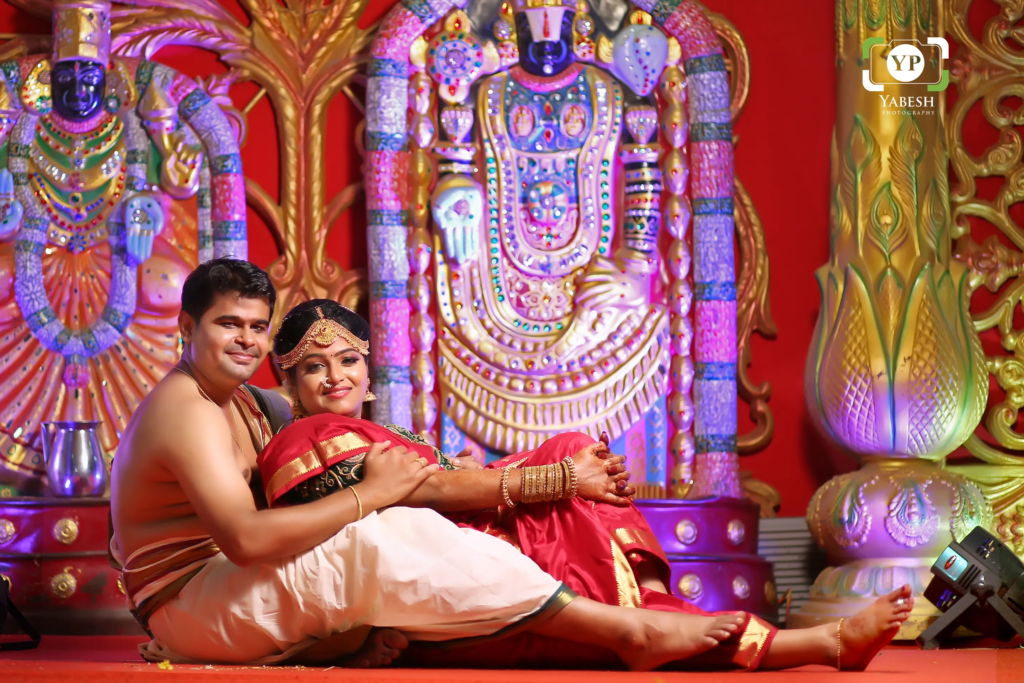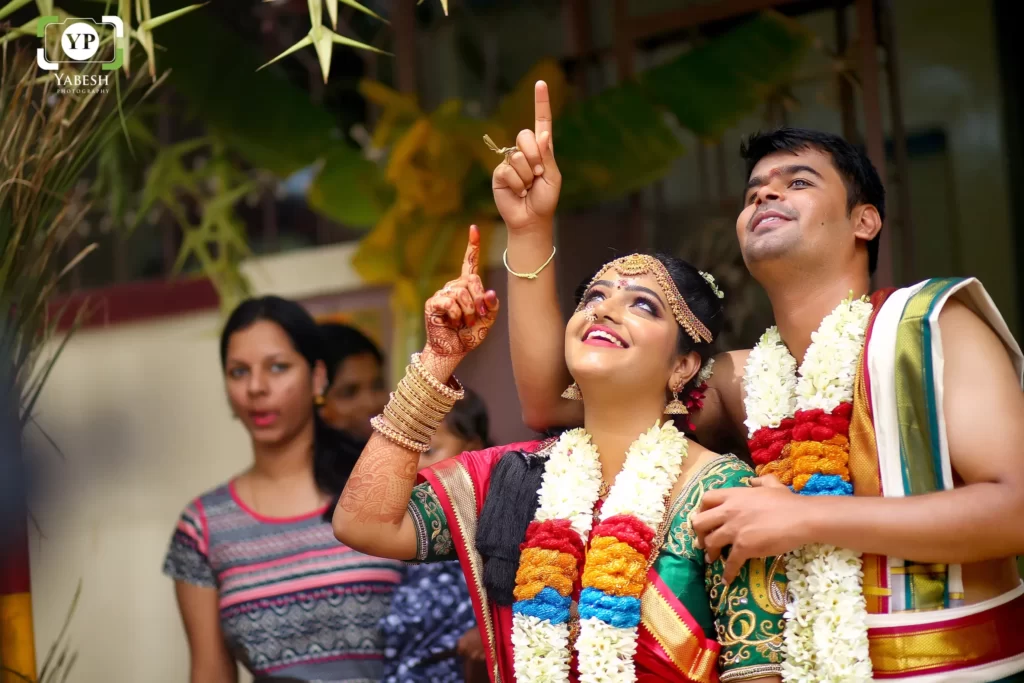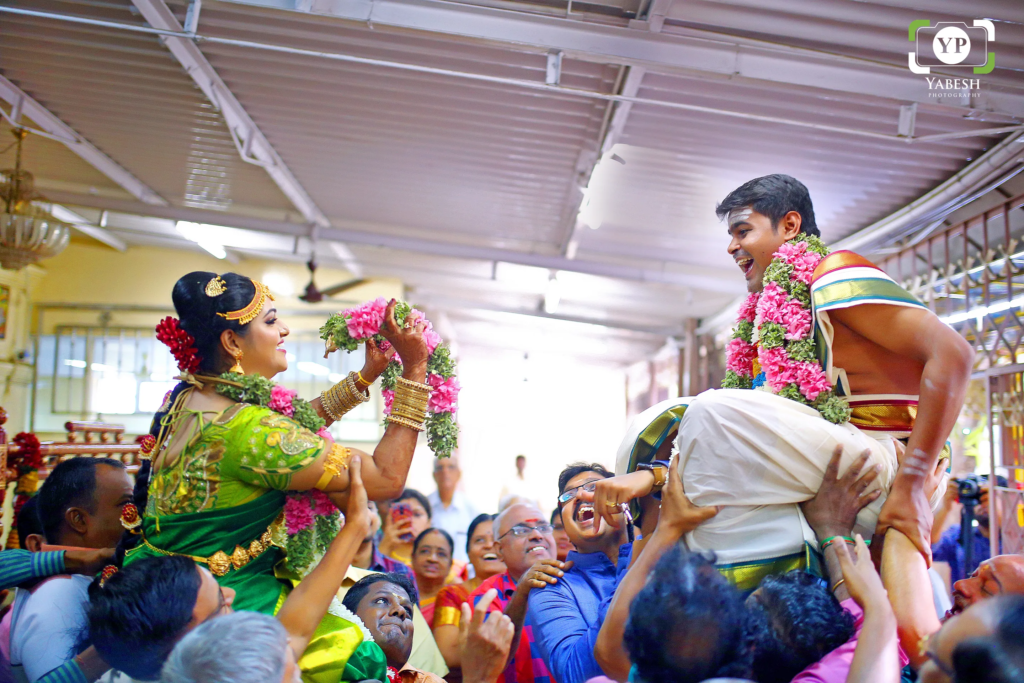Welcome to the enchanting world of Tamil Brahmin weddings, where age-old traditions meet modern elegance in a celebration of love, spirituality, and cultural heritage. In this comprehensive guide, we embark on a journey to explore the rich tapestry of rituals and customs that make a Tamil Brahmin wedding a truly unique and unforgettable experience. Join us as we delve deep into the spiritual significance of each ceremony, from the sacred Vratham to the joyous Oonjal, and discover the intricate blend of tradition and modernity that defines Tambrahm weddings in 2023.
The Essence of a Tamil Brahmin Wedding
A Tamil Brahmin wedding is a harmonious blend of spiritual devotion, cultural splendor, and familial bonds. Conducted under the guidance of a knowledgeable priest, this sacred union is a testament to the enduring traditions that have been passed down through generations.
Attire and Setting: The bride and groom don attire that reflects the essence of Indian heritage. The bride graces the occasion in a resplendent saree adorned with traditional gold jewelry, while the groom complements her in classic Indian attire. The venue for this auspicious event is often a serene temple for the ceremony, followed by a grand banquet hall for the reception.
The Spiritual Connection: At the heart of every Tamil Brahmin wedding lies a deep spiritual connection. Each ritual is carefully designed to invoke blessings upon the newlyweds, fostering an environment of love, understanding, and harmony.
Unraveling the Tapestry of Tamil Brahmin Wedding Rituals
Pandhal Kaal Muhurtham: A Prelude of Protection
A few days before the wedding, the bride’s family embarks on a spiritual journey by offering prayers to the deity symbolized by a bamboo pole. This act symbolizes the resilience required to withstand life’s storms and ensure a smooth wedding journey.
Paalikai Seeds Sowing: Fertility and Blessings
In a beautiful prelude to the wedding, the bride’s family engages in an age-old fertility rite, seeking blessings from the nine devatas for the couple’s health and future offspring. Earthen pots filled with pre-soaked cereals are sown, and the sprouted seedlings are later dispersed in a pool or river.
Welcoming the Groom: A Traditional Welcome
A day before the wedding, the bride’s family extends a warm and traditional welcome to the groom and his family. A thali (tray) filled with flowers, pakku, vetrilai, and fruits is prepared, and the groom is greeted with rose water, Chandanam thilakam, kungunam, and a sweet milk-based dish known as Thirattipal.
Vratham: The Transition to Grihasta Ashram
The Vratham ceremony marks the groom’s transition from bachelorhood (Brahmacharya) to the householder (Grihasta). This sacred ritual is performed separately by the bride and groom, with mantras chanted to invoke the protection of deities.
Naandhi: Honoring the Ancestors
In this ceremony, Brahmins are honored with sweets and gifts as representatives of the groom and bride’s ancestors. Both families seek their blessings, strengthening the familial bonds.
Jaana Vaasam: A Grand Parade
Jaana Vaasam is a vibrant procession where the groom arrives in a beautifully decorated car, accompanied by the bride’s parents, from a nearby temple to the mandapam. This spectacle is filled with music, fireworks, and dancing children, symbolizing the public approval of the chosen groom.
Nichchiyadhartham: The Official Engagement
Nichchiyadhartham marks the official engagement in Tambrahm marriages. It commences with Ganesh Pooja by the bride’s parents and culminates in an Aarti and garland tied around the bride’s waist.
Lagna Pathrigai: Reading the Wedding Invitation
The priest reads the wedding invitation, announcing the names of three generations of both the bride’s and groom’s lineages, along with venue and muhurtham details. An elaborate dinner follows this ritual.
Mangala Snaanam: Purification of Body and Soul
Mangala Snaanam is a pivotal ritual where the bride and groom take a purifying bath on the morning of their wedding day. Their loved ones apply Haldi-kumkum tilak and oil before the bath, ensuring they are spiritually cleansed and prepared for their union.
Ganapathi Puja: Invoking the Remover of Obstacles
A Tamil Brahmin marriage, like any auspicious event, commences with the invocation of Lord Ganpathi, the remover of obstacles, ensuring a smooth journey into married life.
Navagraha Puja: Seeking Astral Blessings
The families may invite a priest to perform a prayer to appease the nine astral planets, seeking their blessings for a harmonious married life.
Kasi Yatra: A Decision of Destiny
After the Vratham ceremony, the groom faces a pivotal choice: a married life as a Grihasta or asceticism as a Sanyasi. Under Kasi Yatra, the groom begins his journey to Kashi as an ascetic, only to be convinced by the bride’s father to embrace married life.
Vaaku Nichaya Muhoortham: The Solemn Marriage
Fathers of the bride and groom face each other as the priest chants Vedic hymns. This marks the solemnization of the marriage.
Exchanging Garlands: A Joyous Affair
The couple engages in a playful ceremony, exchanging garlands thrice while friends and relatives participate, creating a lively and cherished moment.
Oonjal: Swinging in Unity
Oonjal, a swing, becomes the center stage for the married couple, surrounded by singing ladies. The swaying motion symbolizes the ebb and flow of life and the enduring bond with the divine.
Vara Puja: Worship of the Groom
Vara Puja, the groom’s worship, follows the Oonjal ceremony, symbolizing traditions that protect the couple from malevolent forces and bring good fortune. Rice balls are thrown in circular motions, and women circle the couple with lamps or water containers.
Receiving Groom in the Mandapam: A Blessing from the Father
The bride’s father welcomes the groom at the mandapam, washing his feet and applying kajal to his eyes.
Kanya Dhaanam: A Sacred Offering
In a touching moment, the bride sits on her father’s lap, holding a coconut, and together, they offer it to the groom while her mother pours water over it, signifying the giving away of their daughter. The groom’s family gifts the bride a nine-yard sari (Koorai).
Kankana Dharanam: Binding Vows
The bride ties a string around the groom’s wrist, symbolizing a religious vow that binds them together. Only after this ritual can the groom touch the bride, and he reciprocates by tying a Kankanam on her wrist.
Maangalya Dharanam: Tying the Knot
In this sacred ceremony, the groom ties the Mangala Sutra around the bride’s neck, symbolizing material and spiritual abundance and wealth.
Paani Grahanam: Holding Hands
As mantras are chanted, the bride and groom hold each other’s hands, signifying their commitment and unity until the mantras are completed.
Saptha Padhi: Seven Steps to Forever
A Tamil Brahmin marriage is legally complete only after the Saptha Padhi or seven-step ceremony. Hand in hand, the couple walks seven steps together, representing their lifelong companionship and friendship.
Pradhaana Homam: Paying Respect to Agni
Pradhaana Homam, or hawan, is a ceremony where the couple pays their respects to Agni, the fire god. They walk around the fire, feeding it ghee and sacrificial fuel, signifying Agni as a witness to their union.
Ammi Midithal: Stepping on Solid Ground
Ammi Midithal is a unique Tamil wedding ritual where the bride steps on a grindstone with the groom’s assistance. As a mantra is chanted, it is prayed that the bride’s mind remains firm and resilient in the face of marital challenges.
Sammandhi Mariyaadhai: Exchanging Blessings
The two families exchange gifts, fostering goodwill and celebrating the unity of their loved ones.
Laaja Homam: Offering for a Blessed Life
The bride offers parched rice grains to the sacred fire, praying for her husband’s long and healthy life. Family members participate, symbolizing the enduring connections between their families.
Akshadai Shower: Blessings from Above
Elders shower the newlyweds with saffron and turmeric-coated rice grains, imparting their blessings for a prosperous future.
Paladhaanam: Seeking Elders’ Blessings
The newlyweds seek the blessings of their elders, offering fruits and a token of one rupee as a symbol of respect and gratitude.
Griha Pravesam: Bridal Journey to the Groom’s Home
In the Griha Pravesam ceremony, the bride leaves her maternal home, carrying the holy fire from the Laaja Homam, symbolizing the warmth of her new life with her husband.
Nalungu: Playful Bonding
On the wedding afternoon, the newlyweds indulge in playful activities with guests, showcasing their sporting spirit, strength, kindness, and cooperativeness.
Wedding Reception: Celebrating Love
After the solemn wedding ceremonies, the reception provides a casual and informal platform for guests to meet the newlyweds, offering their congratulations and sharing the joy of the moment.
The 3 Homams: Nighttime Blessings
The three havans or homams performed during the night—Jayaathi Homam, Pravesa Homam, and Sesha Homam—add further depth to the spiritual significance of the marriage.
Thaamboola Charvanam: Blessing with Betel Leaves
In this cherished ritual, the bride’s brother offers the couple their first betel leaf to chew, accompanied by other gifts meant to bless them with children and a long life, ushering in good luck and prosperity.
Mangala Arathi: Protection from the Evil Eye
A special solution of turmeric powder and lime is prepared to protect the bride and groom from the evil eye. It is circled during and after the wedding.
Kattu Saadham: Parting Gifts
The day after the wedding, the bride’s family prepares condiments and cooked food as parting gifts for the groom’s family, ensuring they leave with blessings and good wishes.
Frequently Asked Questions
1. What does a traditional Tamil Brahmin bride wear? A traditional Tamil Brahmin bride typically adorns a red saree, symbolizing auspiciousness, and pairs it with gold or silver jewelry. Her hair is styled elegantly, often with a gajra or floral headpiece. The red bindi, bangles, and vermilion powder complete her look.
2. What is the total cost of a Tamil Brahmin wedding? The cost of a Tamil Brahmin wedding can vary but may exceed Rs. 12 lakhs, covering expenses such as the venue, catering, decorations, and more.
3. How long does a Tamil Brahmin wedding last? A Tamil Brahmin wedding typically spans two days but can extend to five days, including pre-wedding ceremonies, wedding day rituals, and post-wedding functions. Guests adorn traditional South Indian attire during these festivities.
4. What happens in a Brahmin wedding? A Brahmin wedding is a sacred and ceremonial union where two individuals exchange vows, rings, and garlands. A priest officiates the ceremony, and it culminates in a meal shared with guests to celebrate the couple’s new life together.
In conclusion, a Tamil Brahmin wedding is a beautiful tapestry of traditions and customs that reflect the cultural and spiritual significance of this sacred union. It is a celebration of love, spirituality, and family bonds, where every ritual holds a deeper meaning and purpose. As we’ve explored the intricate details of each ceremony, we hope to have unveiled the timeless beauty of Tamil Brahmin weddings, inviting you to cherish the depth of tradition and the magic of modernity that defines these celebrations in 2023.




